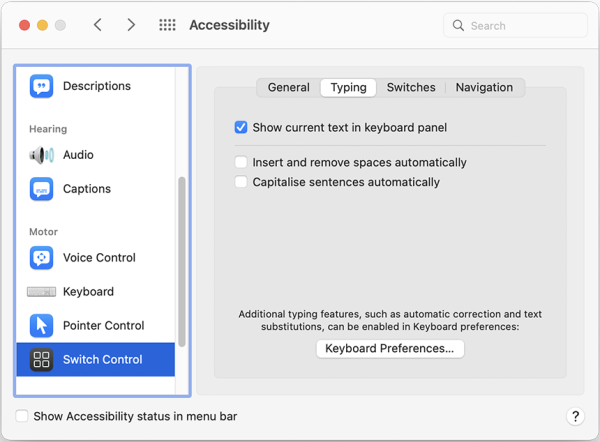How to find and use the accessibility features on Mac OS
Accessibility Settings
1. Opening System Preferences
On MacOS, “Settings” is called “System Preferences”.
- To open System Preferences, click the Apple menu on the Mac’s dock, which is on the top left side of the screen, and is depicted as the Apple logo.
- Select System Preferences from the drop-down menu
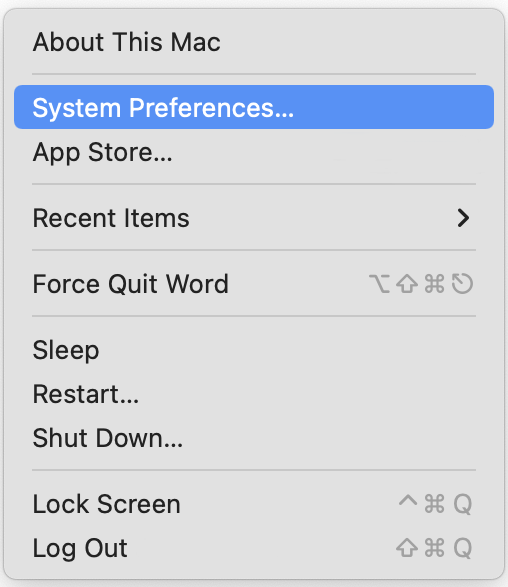
2. Finding Accessibility
Once System Preference is open, it is easy to find Accessibility. Accessibility houses the assistive features offered on MacOS. Select the button to access the menu.
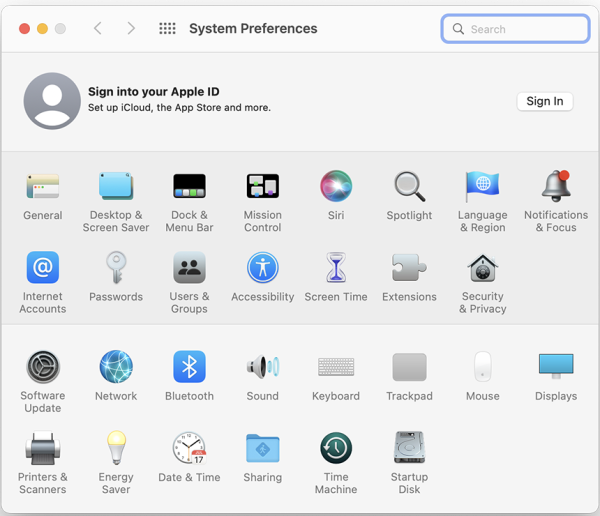
Vision-Related
1. VoiceOver
VoiceOver is a built-in screen reader that provides an audible description of what is happening on screen. This is beneficial for users with visual impairments.
Use the following methods to switch on VoiceOver:
- Open System Preferences and select Accessibility.
- Find VoiceOver on the left-hand panel.
- Tick the box that says “Enable VoiceOver”.
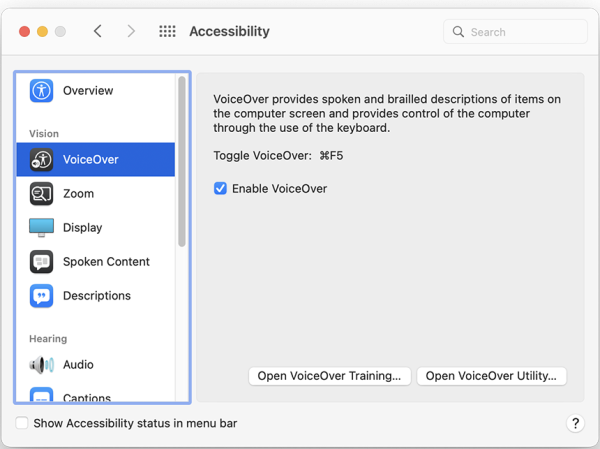
- When the pop-up prompt appears, select “Use VoiceOver” to enable the feature.
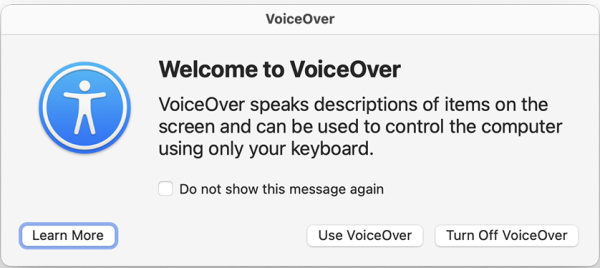
- Alternatively, users can use the keyboard shortcut Command–F5 to enable VoiceOver.
2. Zoom
Zoom allows users to magnify certain areas of their screen to view content more clearly.
2.1. Use keyboard shortcuts to zoom
- Open System Preferences and select Accessibility.
- Find Zoom on the left-hand panel.
- Tick the box that says “Use keyboard shortcuts to zoom”.
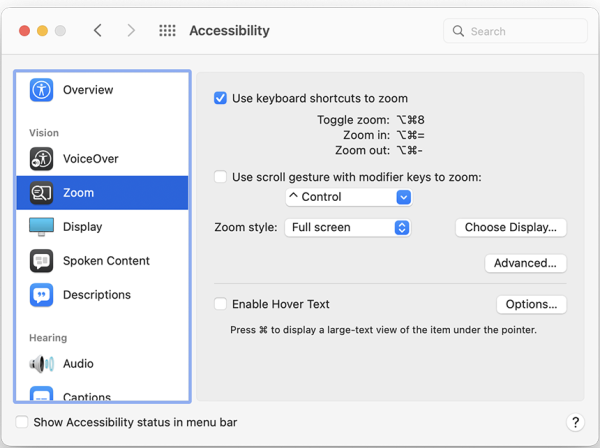
- Use keyboard shortcuts to zoom in. such as:
- Zoom in: Option–Command–Equals sign (=)
- Zoom out: Option–Command–Minus sign (-)
- Toggle zoom: Option–Command–8
- Exit toggle zoom mode: Option–Command–8 again
2.2. Use scroll gesture with modifier keys to zoom
- Enter the Zoom section in Accessibility.
- Click Use scroll gesture with modifier keys to zoom
- The default key is ^Control at the left bottom of the keyboard.
- You can now zoom in or out by pressing the ^Control while using two fingers to slide up or down.
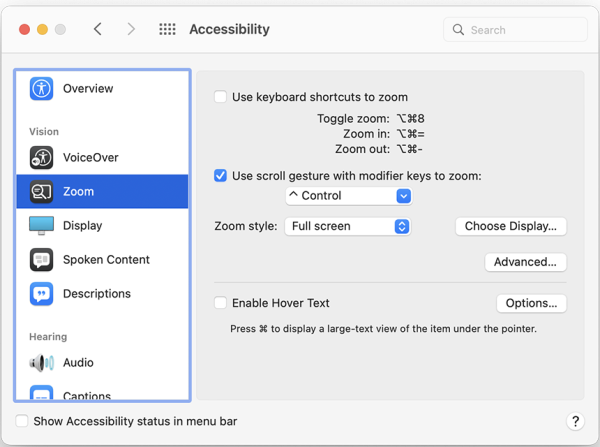
2.3. Enabling hover text:
Hover Text displays an enlarged view of whatever is under the mouse pointer when the command button is pressed. To enable this feature:
- Tick the box next to “Enable Hover text”.
- Now you can zoom in by holding the Command key and placing the pointer on the item we want to zoom in on.
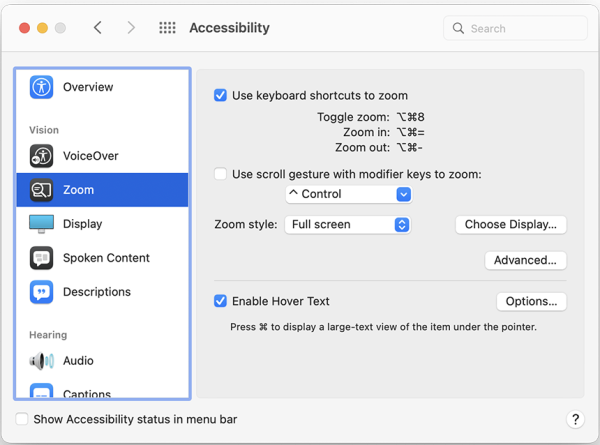
2.4. Enable touch bar zoom
Enable Touch Bar zoom is an advanced function for MacBook Pro with a touch bar, which will zoom in the touch bar content once people place and hold their finger on the touch bar.
- Tick Enable Touch Bar Zoom
- Now the information on the touch bar will zoom in and display on the screen once the user places their finger on it.
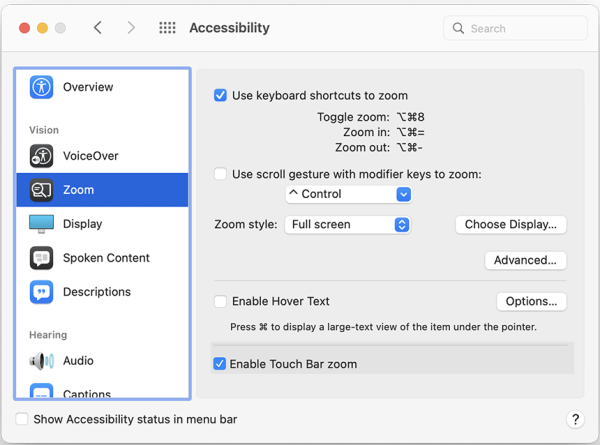
3. Display Settings
3.1. Accessing Display Settings
- Click the Apple menu.
- Open System Preferences and select Accessibility.
- Find Display on the left-hand panel.
- Select the Display tab.
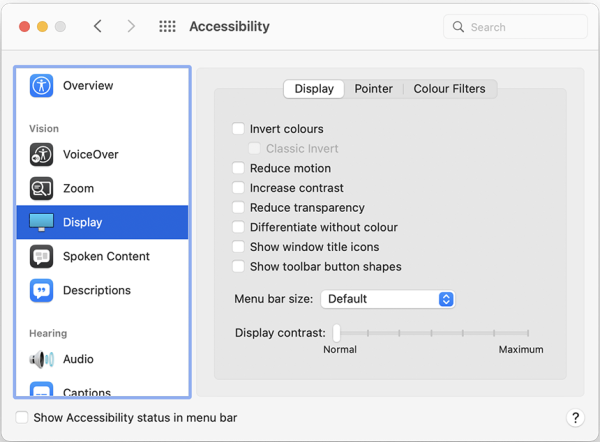
3.2. Display
Under the display tab, there are multiple features to change to the user’s preference:
- Invert colours: Invert the colours on the display.
- Reduce motion: Reduce the movement of elements on the screen.
- Increase contrast: Increase the contrast of items on screen without changing the contrast of the screen. This improves readability on-screen.
- Reduce transparency: Replace the transparent effect on some backgrounds with a darker background.
- Differentiate without colour: Use shapes, not colour, to convey information or status.
- Menu bar size: Change the font size in the menu bar to Large or Default. The user will need to log out and then log back in to see the change.
- Display contrast: Use the slider to increase or decrease the contrast of the screen.

3.3. Pointer
Under the Pointer tab, there are four options to change mouse preferences:
- Shake mouse pointer to locate: Quickly move the mouse pointer back and forth to make it bigger
- Pointer Size: To change the pointer size, move the dot along with the slider.
- Pointer outline colour: To change the point outline colour click on the colour field and choose the Palette.
- Pointer fills colour: To change the point fill colour click on the colour field and choose the Palette.
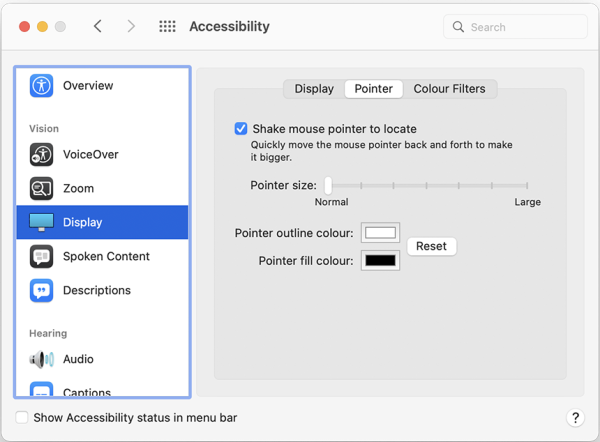
3.4. Colour Filters
Under the Colour Filters tab, users can enable colour filters and change the filter type:
- Enabling colour filters: To enable colour filters, tick the box next to “Enable Colour Filters”.
- Changing the filter type: To change the filter type, click on the drop-down menu to select a filter.
Note: The selection of particular filters will produce additional preference options. For example, certain colour blindness filters give users the option to change the intensity.
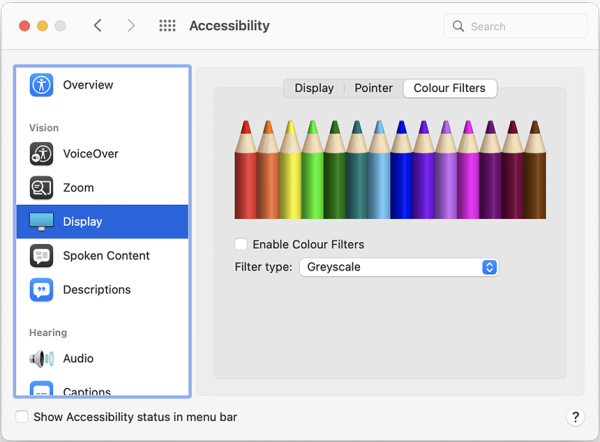
4. Dark Mode
MacOS allow users to change the appearance of their system. There are three modes: Light, Dark and Auto (Auto changes from Light mode to Dark mode depending on the time of day).
Enabling Dark Mode
- Click the Apple menu.
- Open System Preferences and select General.
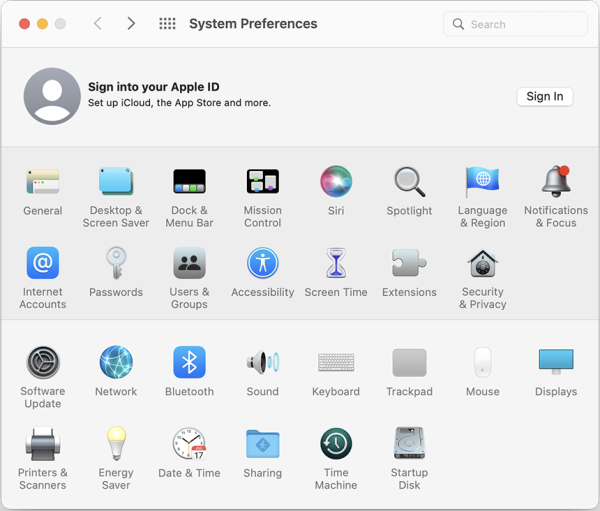
- Search for the “Appearance” options and select Dark.
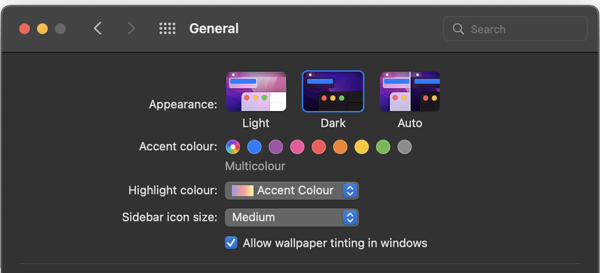
- The Dark Mode theme should now be applied.
5. Spoken Content
MacOS gives users the option to change the voice they hear when the system reads content on the page.
- Click the Apple menu.
- Open System Preferences and select Accessibility.
- Find Spoken Content on the left-hand panel.
- From the Spoken Content menu, you can change the following settings:
- Changing the system voice: Choose a voice to speak text and alerts; click Play to hear a sample.
- Changing the speaking rate: Set the speed at which text is spoken.
- Volume: Set the volume at which text is spoken. Setting the volume here doesn’t affect the volume set for your Mac in Sound System Preferences.
- Speak announcements: Have your Mac announce and speak dialogues and other announcements.
- Speak selection: Have your Mac speak selected text when you press the specified keyboard shortcut.
- Speak items under the pointer: Have your Mac identify items under the pointer.
- Speak typing feedback: Have your Mac speak what you type, select or press using the keyboard.
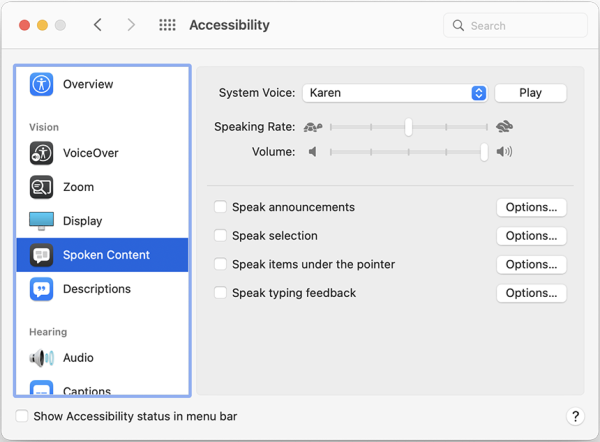
6. Audio Descriptions
Audio Descriptions provide spoke descriptions of visual content in media. If audio descriptions are available, they will play if the feature is enabled.
Enabling Audio Descriptions
- Click the Apple menu.
- Open System Preferences and select Accessibility.
- Find Descriptions on the left-hand panel.
- Tick the box that says, “Play audio descriptions when available”.
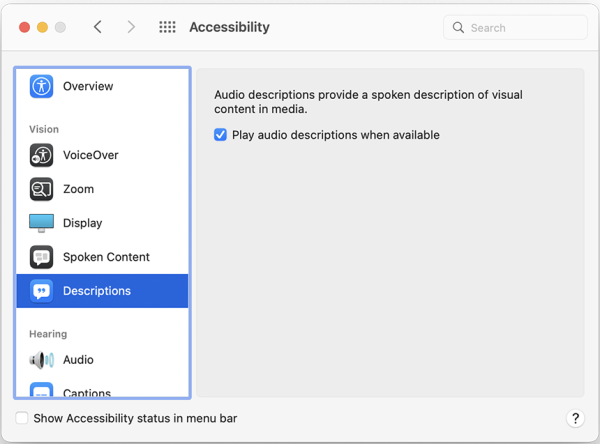
Hearing-Related
1. Audio
Accessing Audio
- Click the Apple menu.
- Open System Preferences and select Accessibility.
- Find Audio on the left-hand panel.
- From the Audio panel, you can change the following settings:
- Flash screen when an alert sounds: Makes your screen flash when you receive an alert.
- Test screen flash: Demonstrate a screen flash.
- Play stereo audio as mono: Make your Mac play stereo audio tracks as mono audio in the left and right speakers or headphones.
Note: System volume preferences can be adjusted even more in the Sound Preferences settings. To go to Sound Preferences, select the button at the bottom of the screen or click the Sound option on the System Preferences menu.
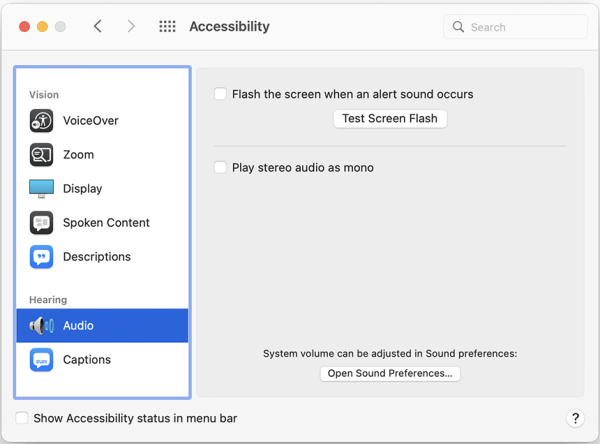
2. Audio Captions
Audio captions include captions and subtitles. Captions are the text version of the audio media being viewed and provide additional information such as descriptions of background noise and other audio cues (for example, a phone ringing). Subtitles are a text alternative for spoken dialogue (for example, translations for people who do not speak the language of the dialogue in a film, TV series or video.)
To find Captions:
- Click the Apple menu.
- Open System Preferences and select Accessibility.
- Find Captions on the left-hand panel.
- From the Captions menu, you can change the following settings:
- Styles list: Choose from available built-in caption style including transparent background, classic, large text and outline text.
- Prefer closed captions and SDH: If they’re available, use closed captions or SDH instead of standard subtitles for content played on your Mac.
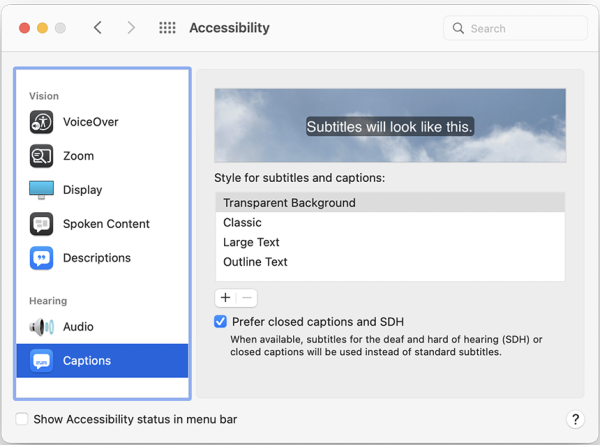
General and Mobility-Related
1. Voice Control
With Voice Control in macOS Big Sur, users can use speech commands to control their devices. The feature has been designed for those folks with limited dexterity, mobility, and other conditions available on iPhone, iPad, and Mac. It also serves as a great new way to interact with your devices.
Enable Voice Control
- Click the Apple menu.
- Open System Preferences and select Accessibility.
- Find Voice Control on the left-hand panel.
- Tick the box that says, “Enable Voice Control”.
Note: it might take new users some time to download. - Furthermore, you can also change languages or microphone output.
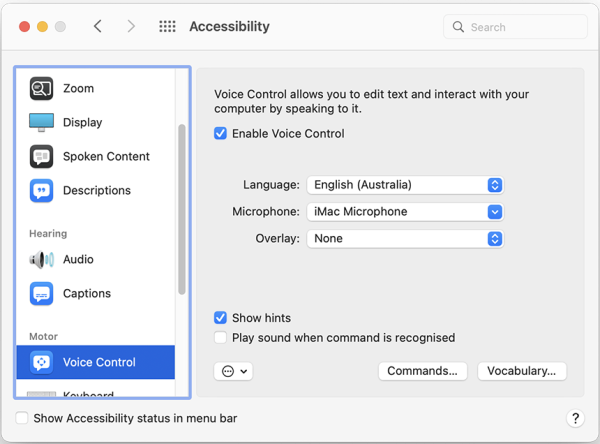
2. Keyboard
2.1. Accessing Keyboard
- Click the Apple menu.
- Open System Preferences and select Accessibility.
- Find Keyboard on the left-hand panel.
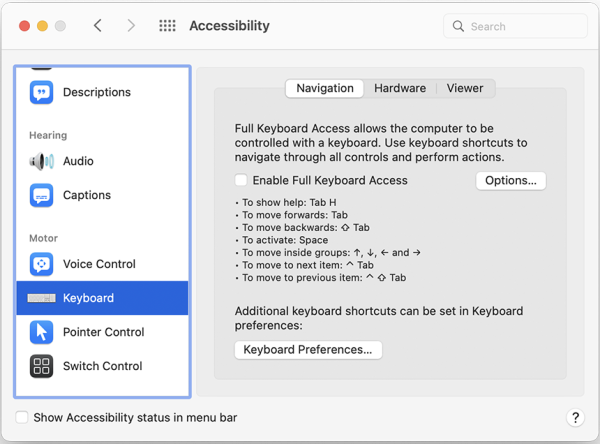
2.2. Navigation
Navigation pane is a function that allows you to control your computer and perform various actions by using keyboard shortcuts. To allow this function:
- In the Keyboard, section click on Navigation tab
- Tick the box next to Enable Full Keyboard Access
- This will unlock full keyboard shortcuts such as:
- To show help: Tab H
- To move forwards: Tab
- To move backwards: ↑Tab
- To activate: Space
- To move inside groups: ↑,↓,← and →
- To move to the next item: ^Tab
- To move to the previous item: ^↑Tab
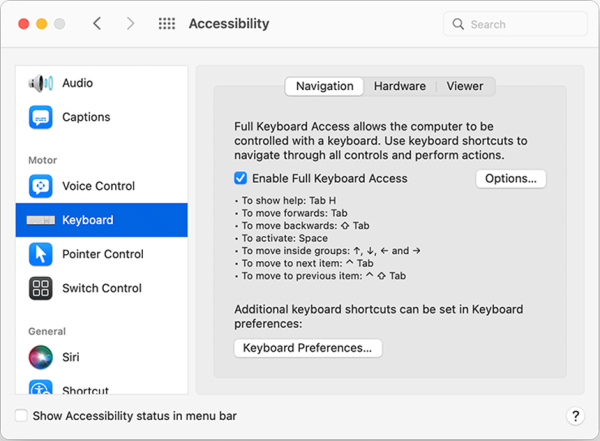
Furthermore, you can click on the Keyboard Preference to access the full shortcuts and make changes according to your preferences.
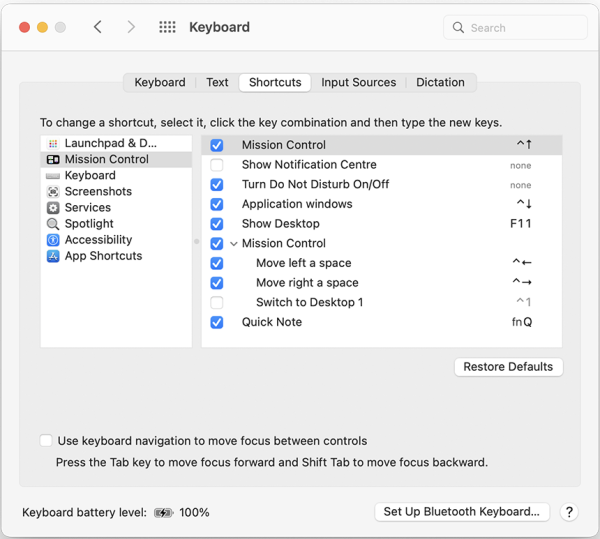
2.3. Hardware
From the Hardware tab, you can change settings for Sticky keys and Slow keys.
Sticky Keys allows modifier keys to be set without having to hold the key down. To enable:
- Click the Hardware tab.
- Tick the box next to “Enable Sticky Keys”.
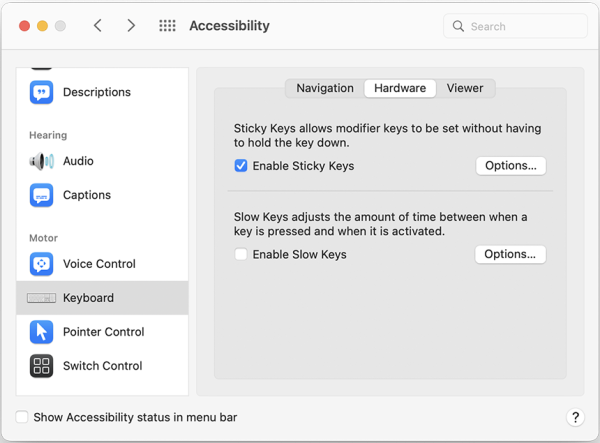
- You can change Sticky Keys options by clicking the Options button next to the Sticky Keys option and change the following settings:
- Press the Shift key five times to toggle Sticky Keys: Use your keyboard to turn Sticky Keys on or off.
- Beep when the modifier key is set: Have your Mac make a sound when you press a modifier key.
- Display pressed keys on screen: Choose the area of the screen where you want to display symbols to indicate which modifier keys you press.
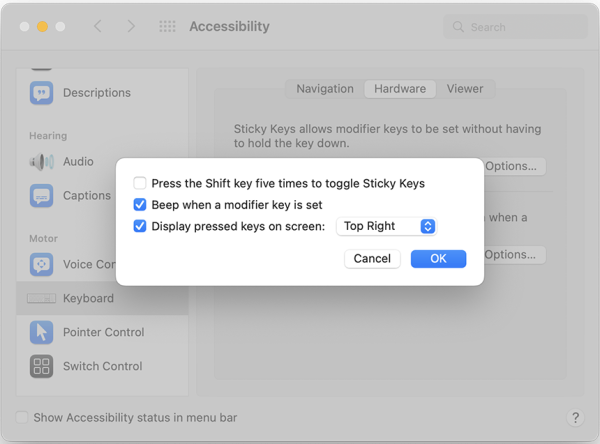
Slow Keys adjusts the amount of time that passes between when a key is pressed and when it activates. To enable:
- Click the Hardware tab.
- Tick the box next to “Enable Slow Keys”.
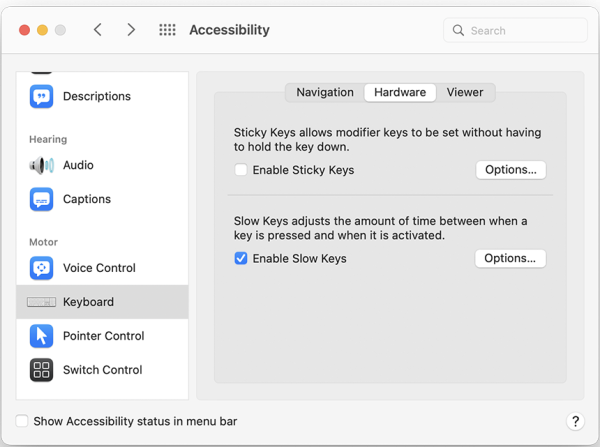
- You can change Slow Keys options by clicking the Options button next to the Sticky Keys option and change the following settings:
- Use click key sounds: Have keys make a sound when pressed. One sound plays when you press a key and a different sound plays when the key press is accepted.
- Acceptance Delay: Set the delay between when you press a key and when it’s accepted.
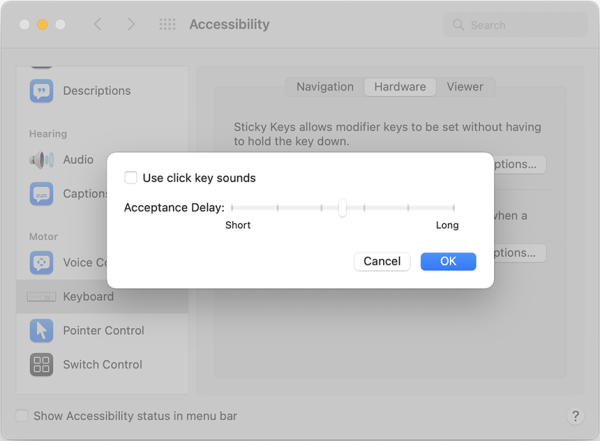
2.4. Viewer
From the Viewer tab, you can change settings for the Accessibility Keyboard
The Accessibility Keyboard lets users interact with the system without using a physical/hardware keyboard.
Enabling Accessibility Keyboard:
- Click the Accessibility Keyboard tab.
- Tick the box next to “Enable Accessibility Keyboard”.
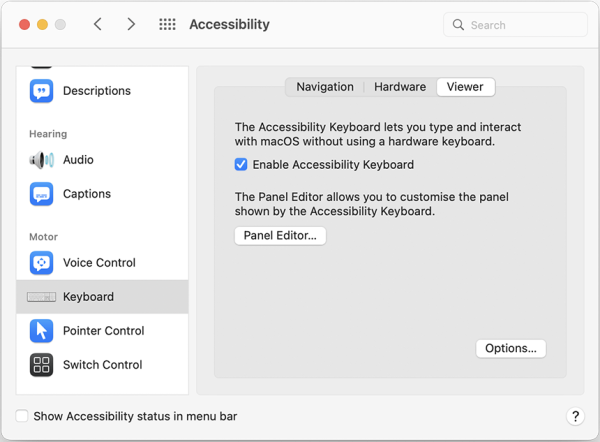
- Use the mouse pointer to click the keyboard to use.
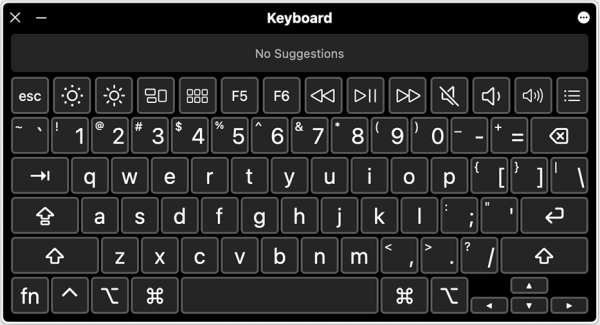
3. Pointer Control
Users can change the method in which they move the mouse pointer or pointer, which is especially helpful if they cannot use a mouse or touchpad.
3.1. Accessing Pointer Control
- Click the Apple menu.
- Open System Preferences and select Accessibility.
- Find Pointer Control on the left-hand panel.
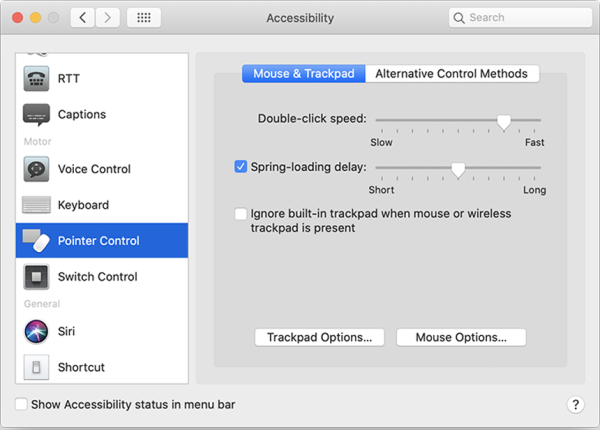
3.2. Mouse & Trackpad
From the Mouse & Trackpad tab, you can change the following settings:
- Double-click speed: Adjust the mouse or trackpad’s reaction time when you double-click an item.
- Sprint-loading delay: Control the timing when you drop items into folders and set how long an item has to be over a folder before the folder opens.
- Ignore built-in trackpad when mouse or wireless trackpad is present: Disable the built-in trackpad on your Mac when you use a mouse or wireless trackpad.

You can click on the Trackpad options where you can change the following settings for the Trackpad:
- Scrolling speed: The speed at which you scroll through documents and windows using the trackpad.
- Scrolling: Turn scrolling on or off. Choose an option to control what happens when you lift your finger from the trackpad:
- Enable Dragging: Turn dragging on or off. Choose an option to control dragging
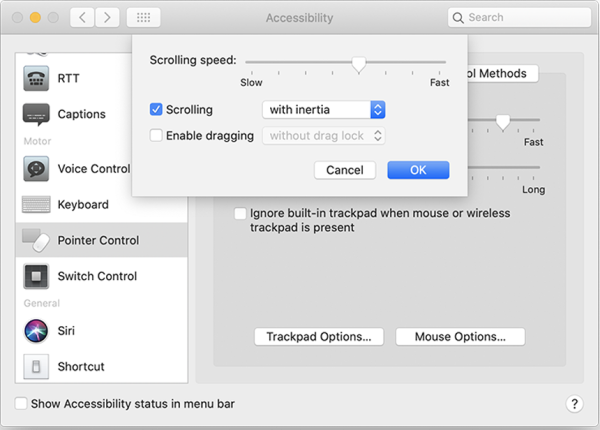
You can click on the Mouse options where you can change the following settings for the Mouse:
- Scrolling speed: The speed at which you scroll through documents and windows using the mouse.
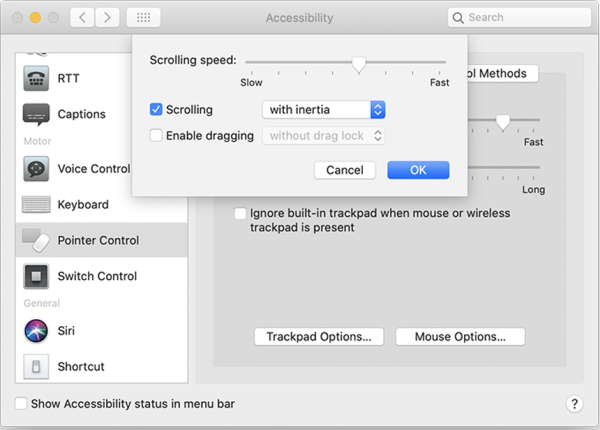
3.3. Alternative Control Methods
From the Alternative Control Methods tab, you can change the following settings:
- Mouse Keys: Allows the pointer to be controlled using the keyboard keys or number pad.
- Alternative Pointer Options: Allows a switch or facial expression to be used in pace of mouse buttons or pointer actions like left-click and right-click.
- Head Pointer: Allows the pointer to be controlled using the movement of your head captured by the camera.
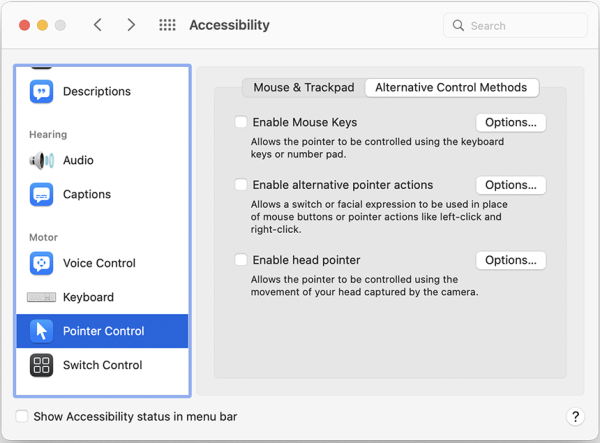
4. Switch Control
Switch Control allows the user’s Mac to be controlled using multiple switches, such as a mouse, keyboard, gamepad devices and other adaptive devices.
4.1. Accessing Switch Control
- Click the Apple menu.
- Open System Preferences and select Accessibility.
- Find Switch Control on the left-hand panel.
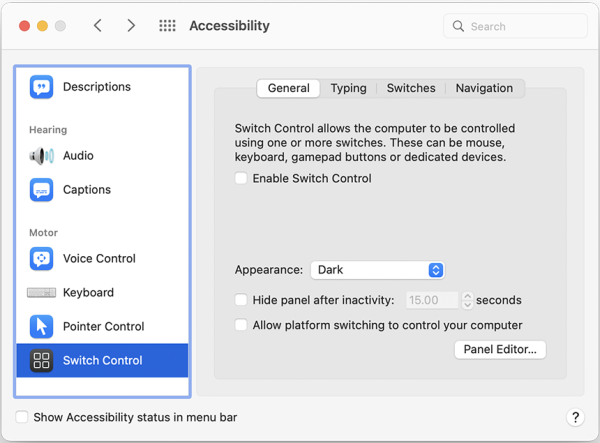
4.2. Enable Switch Control
- Click the Apple menu.
- Open System Preferences and select Accessibility.
- Find Switch Control on the left-hand panel.
- Under the General tab, tick the box next to “Enable Switch Control”.
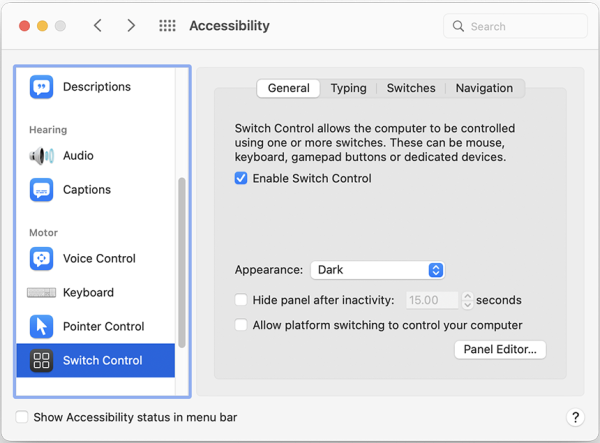
- The flowing screen will appear

- Now you can choose to use what switches to control your MacBook according to your preferences.
- Furthermore, you can also change the appearance between Dark or Light

4.3. Typing
From the Typing tab, you can change the following settings:
- Show current text in keyboard panel: Display a bar at the top of the keyboard panel to display text as you currently typing.
- Insert and remove spaces automatically: Let Switch Control manage spaces as it automatically corrects spacing after a full stop or between sentences.
- Capitalise sentences automatically: Let Switch Control manage capitalisation as it automatically capitalises letters after a full stop.
4.4. Switches
On your Mac, use the Switches pane of Switch Control preferences to add and delete switches, assign actions to switches, and set options for auto scanning.
- Required: Switch Control requires the Select Item switch. When auto scanning is on, Switch Control automatically moves to the next item as it steps through a panel, group or the user interface.
- Optional: Optional switches to use, regardless of whether auto scanning is on or off.
- Add +, Remove – : Add or remove an optional switch.
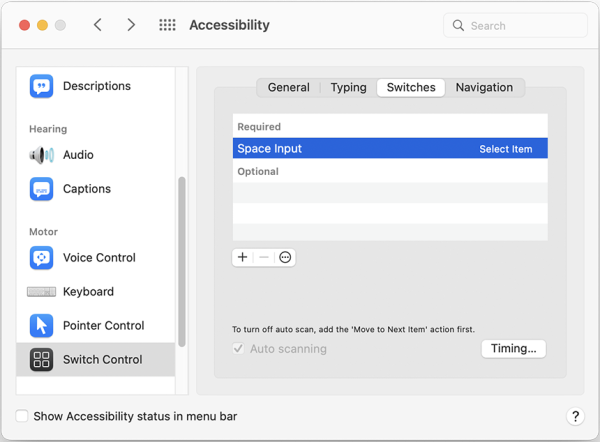
4.5. Navigation
From the Navigation tab, you can change the following settings:
- While navigating: Choose what happens when an item is highlighted during a scan.
- Restart position: Choose the position from where to start when you rescan an item.
- Auto scanning after select: Decide whether it can do auto scanning or not after an item has been selected.
- When the pointer reaches edge: Choose the action taken when the pointer reaches a boundary while scanning the user interface.
- Switch Control cursor size: Choose the thickness of the border of the Switch Control cursor when scanning the user interface.
- Pointer precision: Choose the precision with which you control the pointer when selecting an item on the screen.
- Loops: The number of times, up to 10, that a panel, group, or window is scanned.
- Timing: Set timing options for navigation.
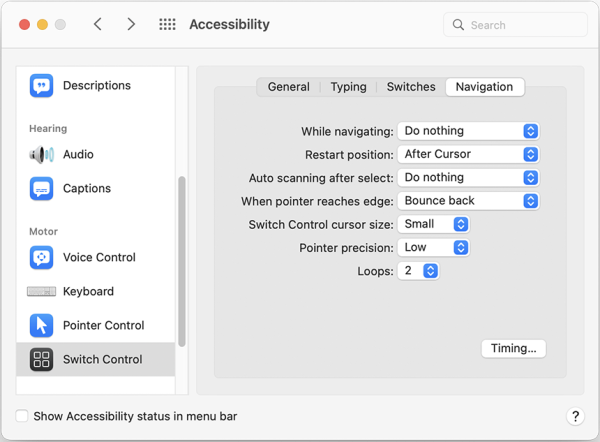
5. Dictation
With keyboard dictation, you can dictate text anywhere you can type it.
- Click the Apple menu.
- Open System Preferences and select Keyboard.
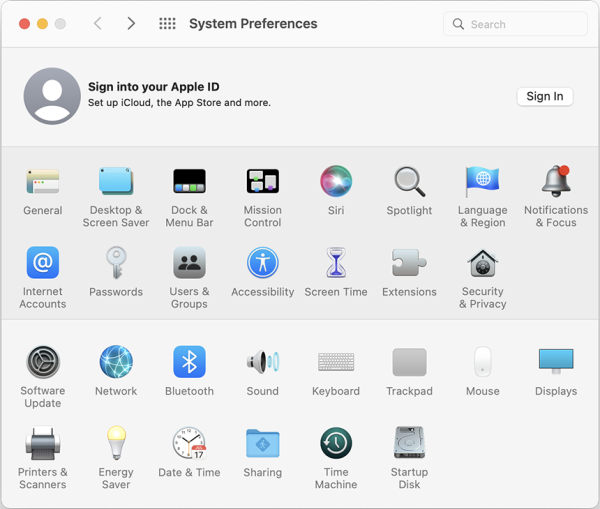
- From the Dictation tab, you can change the following settings:
- Microphone: Click the pop-up menu below the microphone icon, then choose a microphone. If you choose Automatic, your Mac listens to the device you’re most likely to use for keyboard dictation.
- Dictation: Turn keyboard dictation on and off.
- Language: Choose a language. Keyboard dictation is not available in all languages.
- Shortcut: Click the Shortcut pop-up menu, then choose a shortcut to start Dictation.
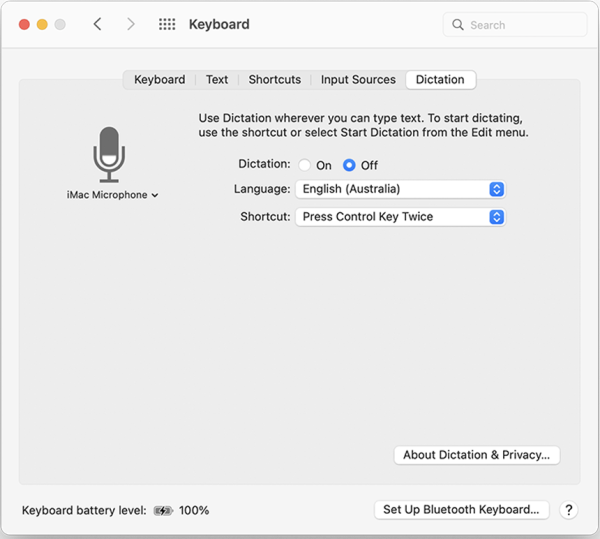
- Once you have turned on Dictation or pressed the shortcut to enable Dictation, the following prompt will appear asking if you want to enable dictation. Tap OK to proceed.
- Another prompt will appear. Tap Enable Dictation to continue.
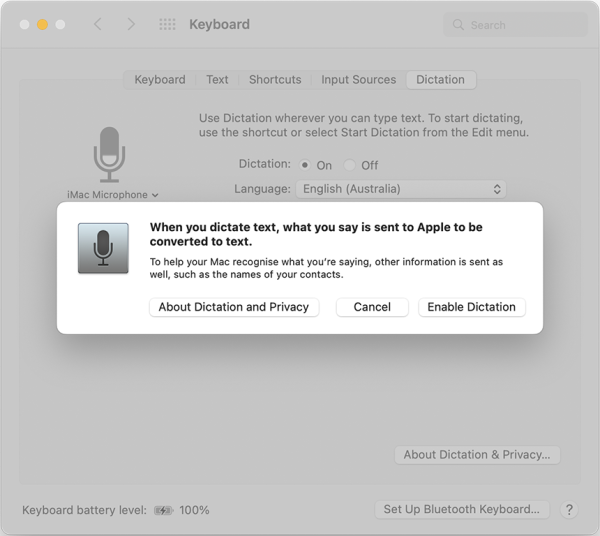
- You can now press the Dictation shortcut that you selected to use Dictation. A microphone icon appears indicating that you can now speak where you would normally enter text.
6. Siri
Siri allows users to type in their requests instead of speaking to them. However, Siri will still listen for voice input when activated from a headset.
Enable Type to Siri
- Click the Apple menu.
- Open System Preferences and select Accessibility.
- Find Siri on the left-hand panel.
- Tick the box that says, “Enable Type to Siri”.
- To use Siri users need to have Siri turned on first, if not turned on users can click on Open Siri Preferences down below and click the box next to Hey Siri.
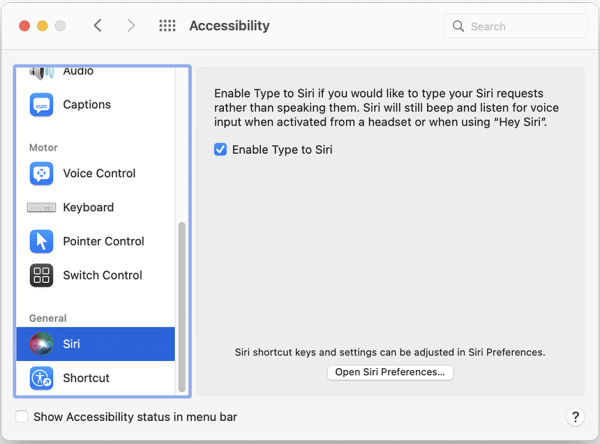
7. Accessibility Shortcuts
Select the shortcuts that appear in the Accessibility Options. Accessibility Options is a panel that lists accessibility features users can quickly turn on or off by pressing the keys: Option + Command + F5. To change the shortcuts displayed, do the following:
- Click the Apple menu.
- Open System Preferences and select Accessibility.
- Find Shortcut on the left-hand panel.
- Tick and untick the options available according to preferences.
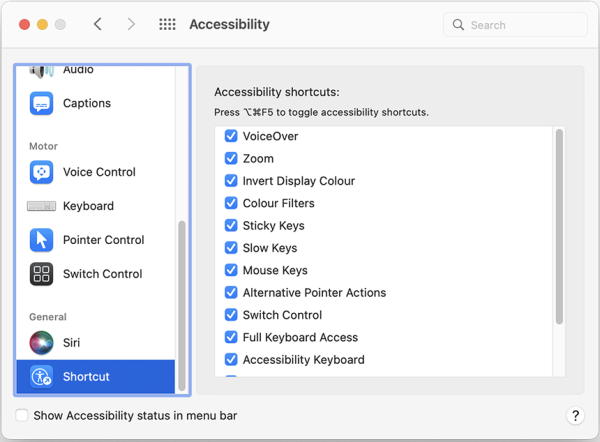
Keyboard Shortcuts
F 0-9 keys are located at the top of the keyboard, if the MacBook has a touch bar then will need to hold the fn key (bottom left corner) to display the F keys.
The control key is located at the bottom left corner with the symbol ^
Option keys are located at the bottom left or bottom right corner with the symbol ⌥
Command keys are located next to the space key with the symbol ⌘
1. Vision-Related Accessibility Features
- Enable/Disable VoiceOver: Command–F5
- Open VoiceOver Utility if VoiceOver is turned on: Control–Option–F8 or Fn–Control–Option–F8
- Enable/Disable zoom: Option–Command–8
- Zoom in: Option–Command–Plus sign (+)
- Zoom out: Option–Command–Minus sign (-)
- Invert colours: Control–Option–Command–8
- Reduce contrast: Control–Option–Command–Comma (,)
- Increase contrast: Control–Option–Command–Period (.)
2. Mobility-Related Accessibility Features
- Enable/Disable Sticky Keys: Press Shift button five times
- Enable Dictation: Press Control twice
Using a keyboard as a mouse:
- Switch between navigation of all controls on the screen, or only text boxes and lists: Control–F7 or Fn–Control–F7
- Move to the next control: Tab
- Move to the previous control: Shift–Tab
- Move to the next control when a text field is selected: Control–Tab
- Move the focus to the previous grouping of controls: Control–Shift–Tab
- Move to the adjacent item in a list, tab group, or menu. Move sliders and adjusters (Up Arrow to increase values, Down Arrow to decrease values): Arrow keys
- Move to a control adjacent to the text field: Control–Arrow keys
- Choose the selected menu item: Space bar
- Click the default button or perform the default action: Return or Enter
- Click the Cancel button or close a menu without choosing an item: Esc
- Move the focus to the previous panel: Control–Shift–F6
- Move to the status menu in the menu bar: Control–F8 or Fn–Control–F8
- Activate the next open window in the front app: Command–Grave accent (`)
- Activate the previous open window in the front app: Shift–Command–Grave accent (`)
- Move the focus to the window drawer: Option–Command–Grave accent (`)
Navigating menus with a keyboard:
- Focus on menu bar (necessary to use the following shortcuts): Control–F2 or Fn–Control–F2
- Move from menu to menu: Left Arrow, Right Arrow
- Open a selected menu: Return
- Move to menu items in the selected menu: Up Arrow, Down Arrow
- Jump to a menu item in the selected menu: Type the menu item’s name
- Choose the selected menu item: Return
Use Mouse Keys to move the mouse pointer:
- Move up: 8 or numeric keypad 8
- Move down: K or numeric keypad 2
- Move left: U or numeric keypad 4
- Move right: O or numeric keypad 6
- Move diagonally down and to the left: J or numeric keypad 1
- Move diagonally down and to the right: L or numeric keypad 3
- Move diagonally up and to the left: 7 or numeric keypad 7
- Move diagonally up and to the right: 9 or numeric keypad 9
- Press the mouse button: I or numeric keypad 5
- Hold the mouse button: M or numeric keypad 0
- Release the mouse button: . (period)
3. General-Related Accessibility Features
- Toggle Accessibility Options: Option–Command–F5
Additional Resources
To learn more about the accessibility features found on MacOS, visit the Apple website through the following links.
For Mac-specific features, click this link: https://support.apple.com/en-au/guide/mac-help/mh35884/mac
For more general information on accessibility, including features found on other Apple devices, click this link: https://www.apple.com/au/accessibility/

